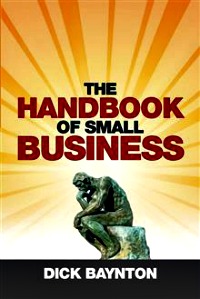Title: The Handbook of Small Business
Author: Dick Baynton
Publisher: XlibrisUS
ISBN: 9781514458129
Pages: 188
Genre: Business & Economics / General
Reviewed by: Dan Macintosh
Buy on AmazonPacific Book Review
The first thing you should know about Dick Baynton’s book, The Handbook of Small Business, is that the operative word in its title is ‘handbook.’ Its 90 (mostly) short chapters are intended to be ready references. It is not, however, the kind of book most people will read chronologically, from start to finish. This is a book pinpointed at anyone serious about starting a small business, and then running that business the right way from the very get-go.
Baynton never promises the reader will excel commercially after applying principles in this book. In fact, he writes in the book’s introduction, “You will not become rich or successful or famous simply by reading this book. However, the ideas offered in these pages should ignite thoughts and actions of creativity that set your company above the competition.”
Why should we take Baynton’s word for it? Well, Baynton has had his own home- building company, as well as a successful distributorship and countertop fabricator. In other words, he knows how to start a successful business because he’s begun a couple of them himself.
Chapters in Baynton’s book are laid out, quite helpfully, in alphabetical order. Although accounts payable may not be your first order of business, at least when it comes to creating a new business, the chapter on this subject is located at the book’s beginning, whereas one concerning vehicles (trucks, vans, cars and such) comes at the end.
In addition to its many chapters, the backside of this book also contains a few helpful appendices. Regarding some of these items, you may not even think about them until your business is beginning to grow a bit. For instance, Appendix H is a sample/model employment application. When it comes time to adding new employees, your company better have some kind of standardized employment application that asks the questions you’ll need answered by your potential employees. On the other hand, it’s questionable that all new businesses will require a metric conversion chart (included), or currency conversions – international – unless the business is making international transactions.
While Baynton’s book is intended primarily for practical purposes, he’s not beyond giving out helpful advice. Chapter 67, for example, is simply titled Procrastination. Within it, he advises, “Here’s an approach to decision making and taking action. Decide on a time and a date in the future when logic dictates that it will be too late to achieve an objective resulting from enacting the decision. Too late may mean taking advantage of a special price or product or service.” Such suggestions are not detailed, but rather logical instructions on avoiding procrastination. In business, as in many other life endeavors, one must many times strike while the iron is hot. Sometimes, too late really is too late.
Another chapter is called Celebrations! Championing business success stories, or even something as simple as employee birthdays, add up to some of the little (yet still important things) that helps keep quality employees happy and loyal. Baynton writes, “Never forget that without high-quality employees, there is no company. Expensive machines and computers, loads of inventory, and a customer list amounting to countless numbers have no value without productive employees.” These words may not describe dollars and cents, but they nevertheless add up to dollars and sense.
Baynton’s handbook is an exhaustive guide for entrepreneurs. When it comes to having a small business companion, ‘exhaustive’ is exactly what you want. Granted, not everything contained within is immediately applicable – at least not at the moment. Some of it may be needed sometime down the line. Who knows, ‘some of it’ might just be what a small business truly needs to survive.


